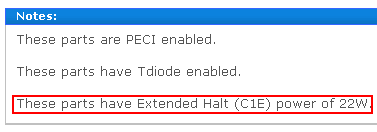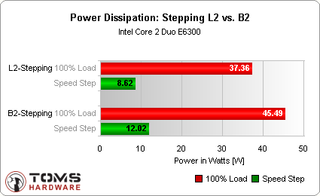Energy Efficiency: AMD vs. Intel
Low power state for the L2 stepping...
Power Dissipation: Idling at under 9 Watts
Intel's specifications for the L2 stepping state that the processor dissipates a maximum of 12 watts of power in C1E mode. The B2 stepping, on the other hand, can draw up to 22 watts.
At any rate, the three L2 models only reach their lowest power consumption when they run at their lowest possible frequency, namely 1.6 GHz. Of course, there is a certain variation across the processor family, which is why Intel defines a maximum value that applies to the entire line.


...and the B2 stepping
To determine what effect these power optimizations have in real-world scenarios, we took exact measurements.

We determined the power dissipation for each processor when idle and again with both cores under full load. In order to simulate a heavy load we used Prime95 in its multiprocessor incarnation.
All measurements for the Core 2 Duo were taken on the Foxconn's Q9657MC-8KS2H MicroATX board. We chose this board because of its low power consumption. Additionally, the board features an integrated graphics solution, which makes a power-hungry add-in graphics solution unnecessary. The processor receives its power from a 4-phase voltage regulator, which is included in our measurements.

Our results show that the L2 stepping has a considerably lower power dissipation. Running idle at 1.6 GHz, the CPU draws 28.29% less power, and 17.88% less when both cores are under full load. That's a full 8.13 watts difference!
Stay on the Cutting Edge
Join the experts who read Tom's Hardware for the inside track on enthusiast PC tech news — and have for over 25 years. We'll send breaking news and in-depth reviews of CPUs, GPUs, AI, maker hardware and more straight to your inbox.
As we can see, the L2 doesn't only offer an improvement when idle, but also saves power under full load.
Current page: Low power state for the L2 stepping...
Prev Page Energy Efficiency: AMD vs. Intel Next Page Intel's boxed coolerTom's Hardware's dedicated news crew consists of both freelancers and staff with decades of experience reporting on the latest developments in CPUs, GPUs, super computing, Raspberry Pis and more.
Most Popular


